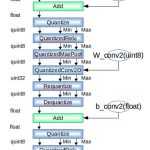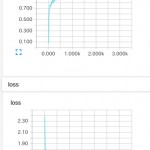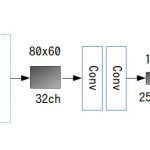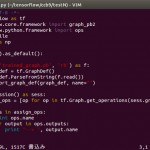TensorFlowのリポジトリを見ていたたらTF-Slimなるものを見つけました。ちょっとさわってみたら何かと便利そうだったので、簡単に使い方をメモっておきます。
注意!:TensorFlow1.0でだいぶAPIが変わってしまったのでここのコードは使えないです
TensorFlow-Slim
https://github.com/tensorflow/tensorflow/tree/master/tensorflow/contrib/slim
TF-Slimとは、複雑なモデルを簡潔に記述するためのライブラリです。定形コードを削除することで、モデルをよりコンパクトに定義出来るようにしているそうです。
さらに、TF-Slimを使うとVGG,AlexNetなど既知のモデルを簡単に使用したり、学習済みモデルを使って転移学習を簡単に行えるらしい。
使ってみる
使い方
import tensorflow.contrib.slim as slim
「Deep MNIST for Experts」をTF-Slimで書く
チュートリアルに載っている多層ニューラルネットワークのサンプルコードをTF-Slimを使って書いてみます。
まずはTF-Slimを使わないコード
import tensorflow as tf
from tensorflow.examples.tutorials.mnist import input_data
mnist = input_data.read_data_sets('MNIST_data', one_hot=True)
sess = tf.InteractiveSession()
def weight_variable(shape):
initial = tf.truncated_normal(shape, stddev=0.1)
return tf.Variable(initial)
def bias_variable(shape):
initial = tf.constant(0.1, shape=shape)
return tf.Variable(initial)
def conv2d(x, W):
return tf.nn.conv2d(x, W, strides=[1, 1, 1, 1], padding='SAME')
def max_pool_2x2(x):
return tf.nn.max_pool(x, ksize=[1, 2, 2, 1], strides=[1, 2, 2, 1], padding='SAME')
x = tf.placeholder(tf.float32, shape=[None, 784])
y_ = tf.placeholder(tf.float32, shape=[None, 10])
x_image = tf.reshape(x, [-1, 28, 28, 1])
#First Convolutional Layer
W_conv1 = weight_variable([5, 5, 1, 32])
b_conv1 = bias_variable([32])
h_conv1 = tf.nn.relu(conv2d(x_image, W_conv1) + b_conv1)
h_pool1 = max_pool_2x2(h_conv1)
#Second Convolutional Layer
W_conv2 = weight_variable([5, 5, 32, 64])
b_conv2 = bias_variable([64])
h_conv2 = tf.nn.relu(conv2d(h_pool1, W_conv2) + b_conv2)
h_pool2 = max_pool_2x2(h_conv2)
#Densely Connected Layer
W_fc1 = weight_variable([7 * 7 * 64, 1024])
b_fc1 = bias_variable([1024])
h_pool2_flat = tf.reshape(h_pool2, [-1, 7*7*64])
h_fc1 = tf.nn.relu(tf.matmul(h_pool2_flat, W_fc1) + b_fc1)
#dropout
keep_prob = tf.placeholder(tf.float32)
h_fc1_drop = tf.nn.dropout(h_fc1, keep_prob)
#Readout Layer
W_fc2 = weight_variable([1024, 10])
b_fc2 = bias_variable([10])
y_conv = tf.matmul(h_fc1_drop, W_fc2) + b_fc2
#Train and Evaluate the Model
cross_entropy = tf.reduce_mean(tf.nn.softmax_cross_entropy_with_logits(y_conv, y_))
train_step = tf.train.AdamOptimizer(1e-4).minimize(cross_entropy)
correct_prediction = tf.equal(tf.argmax(y_conv,1), tf.argmax(y_,1))
accuracy = tf.reduce_mean(tf.cast(correct_prediction, tf.float32))
sess.run(tf.global_variables_initializer())
for i in xrange(20000):
batch = mnist.train.next_batch(50)
if i%100 == 0:
train_accuracy = accuracy.eval(feed_dict={
x:batch[0], y_:batch[1], keep_prob: 1.0})
print("step %d, training accuracy %g"%(i, train_accuracy))
train_step.run(feed_dict={x:batch[0], y_:batch[1], keep_prob: 0.5})
次にTF-Slimを使ったコード
ただ、slim.learning,slim.evaluationはよく分からなかったので使うのやめました-o-;
import tensorflow as tf
import tensorflow.contrib.slim as slim
from tensorflow.examples.tutorials.mnist import input_data
mnist = input_data.read_data_sets('MNIST_data', one_hot=True)
sess = tf.InteractiveSession()
x = tf.placeholder(tf.float32, shape=[None, 784])
y_ = tf.placeholder(tf.float32, shape=[None, 10])
x_image = tf.reshape(x, [-1, 28, 28, 1])
with slim.arg_scope([slim.conv2d, slim.fully_connected],
activation_fn=tf.nn.relu,
weights_initializer=tf.truncated_normal_initializer(stddev=0.1),
biases_initializer=tf.constant_initializer(0.1)):
with slim.arg_scope([slim.max_pool2d], padding='SAME'):
#First Convolutional Layer
h_conv1 = slim.conv2d(x_image, 32, [5, 5])
h_pool1 = slim.max_pool2d(h_conv1, [2, 2])
#Second Convolutional Layer
h_conv2 = slim.conv2d(h_pool1, 64, [5, 5])
h_pool2 = slim.max_pool2d(h_conv2, [2, 2])
#Densely Connected Layer
h_pool2_flat = slim.flatten(h_pool2)
h_fc1 = slim.fully_connected(h_pool2_flat, 1024)
#dropout
keep_prob = tf.placeholder(tf.float32)
h_fc1_drop = slim.dropout(h_fc1, keep_prob)
#Readout Layer
y_conv = slim.fully_connected(h_fc1_drop, 10, activation_fn=None)
#Train and Evaluate the Model
cross_entropy = slim.losses.softmax_cross_entropy(y_conv, y_)
train_step = tf.train.AdamOptimizer(1e-4).minimize(cross_entropy)
correct_prediction = tf.equal(tf.argmax(y_conv,1), tf.argmax(y_,1))
accuracy = tf.reduce_mean(tf.cast(correct_prediction, tf.float32))
sess.run(tf.global_variables_initializer())
for i in xrange(20000):
batch = mnist.train.next_batch(50)
if i%100 == 0:
train_accuracy = accuracy.eval(feed_dict={
x:batch[0], y_:batch[1], keep_prob: 1.0})
print("step %d, training accuracy %g"%(i, train_accuracy))
train_step.run(feed_dict={x:batch[0], y_:batch[1], keep_prob: 0.5})
どのが簡潔になったのか
ネットワーク構築部分が、割とスリムになっているかなと…。
ただ、今回は取り上げた例が良くなくて、もっと複雑なネットワークなら効果がわかりやすかったかも。
畳み込み層
・使わない場合
W_conv1 = weight_variable([5, 5, 1, 32]) b_conv1 = bias_variable([32]) h_conv1 = tf.nn.relu(conv2d(x_image, W_conv1) + b_conv1)
・使った場合
h_conv1 = slim.conv2d(x_image, 32, [5, 5])
Weight,Biasを用意してconv2dしてreluで活性化までを1行で書けます。
変数の初期値は?
TF-Slimを使わない場合は、変数定義を関数に切り出し、
weight : truncated_normal(stddev=0.1)
bias : constant(0.1)
で初期化していました。
def weight_variable(shape): initial = tf.truncated_normal(shape, stddev=0.1) return tf.Variable(initial) def bias_variable(shape): initial = tf.constant(0.1, shape=shape) return tf.Variable(initial)
TF-Slimを使う場合は、
h_conv1 = slim.conv2d(x_image, 32, [5, 5], activation_fn=tf.nn.relu, weights_initializer=tf.truncated_normal_initializer(stddev=0.1), biases_initializer=tf.constant_initializer(0.1))
のように書けばいいのですが、毎回書くのは大変なのでslim.arg_scopeを使うことで、簡潔に書けます。
with slim.arg_scope([slim.conv2d], activation_fn=tf.nn.relu,
weight_initializer=tf.truncated_normal_initializer(stddev=0.1),
biases_initializer=tf.constant_initializer(0.1):
h_conv1 = slim.conv2d(x_image, 32, [5, 5])
とすることで、スコープ内のslim.conv2dの引数に、arg_scopeで定義したものを使うことが出来ます。
また、arg_scopeは入れ子で使用できます。
全結合層
・使わない場合
W_fc1 = weight_variable([7 * 7 * 64, 1024]) b_fc1 = bias_variable([1024]) h_pool2_flat = tf.reshape(h_pool2, [-1, 7*7*64]) h_fc1 = tf.nn.relu(tf.matmul(h_pool2_flat, W_fc1) + b_fc1)
・使う場合
h_pool2_flat = tf.reshape(h_pool2, [-1, 7*7*64]) h_fc1 = slim.fully_connected(h_pool2_flat, 1024)
こちらも、weight,bias定義してmatmul,reluを1行で書けます。
こんなこともできるよ
繰り返し
・使わない場合
net = slim.conv2d(net, 256, [3, 3], scope='conv3_1') net = slim.conv2d(net, 256, [3, 3], scope='conv3_2') net = slim.conv2d(net, 256, [3, 3], scope='conv3_3')
・使う場合
net = slim.repeart(net, 3, slim.conv2d, 256, [3, 3], scope='conv3')
slim.repeartを使って、畳み込み層の繰り返しを1行で書けます。
パラメータを変えて繰り返し
・使わない場合
x = slim.fully_connected(x, 32, scope='fc/fc_1') x = slim.fully_connected(x, 64, scope='fc/fc_2') x = slim.fully_connected(x, 128, scope='fc/fc_3')
・使う場合
slim.stack(x, slim.fully_connected, [32, 64, 128], scope='fc')
slim.stackを使って、ユニット数を変えて全結合層を重ねる処理を1行で書けます。
その他にもコードを簡潔に書くためのモジュールが沢山ありそうですが、今回試してみたのはここまでです。
有名なニューラルネットワークを簡単に
githubにTensorflow/modelsリポジトリがあります。
https://github.com/tensorflow/models/tree/master/slim
この中に、TF-Slimを使って書かれた、
・Inception V1〜V4
・Inception-ResNet-V2
・ResNet 50,101,152
・VGG 16,19
があります。しかもILSVRC-2012-CLSを使って学習した、学習済みのCheckpointファイルも公開されているため、転移学習に使えそうですね。
あとがき
転移学習を試してみたくて、学習済みモデルを集めてたらTF-Slimを見つけました。
畳み込みニューラルネットワークの深層化なんかを試す場合など、同じコードを繰り返すことが多々あると思うので、簡潔にかけるようになると嬉しいですね。これから使っていこうと思います。



![[GCP]Cloud Machine Learningを使ってハイパーパラメータチューニング](http://workpiles.com/wordpress/wp-content/uploads/2017/09/hptuning-150x150.jpg)
